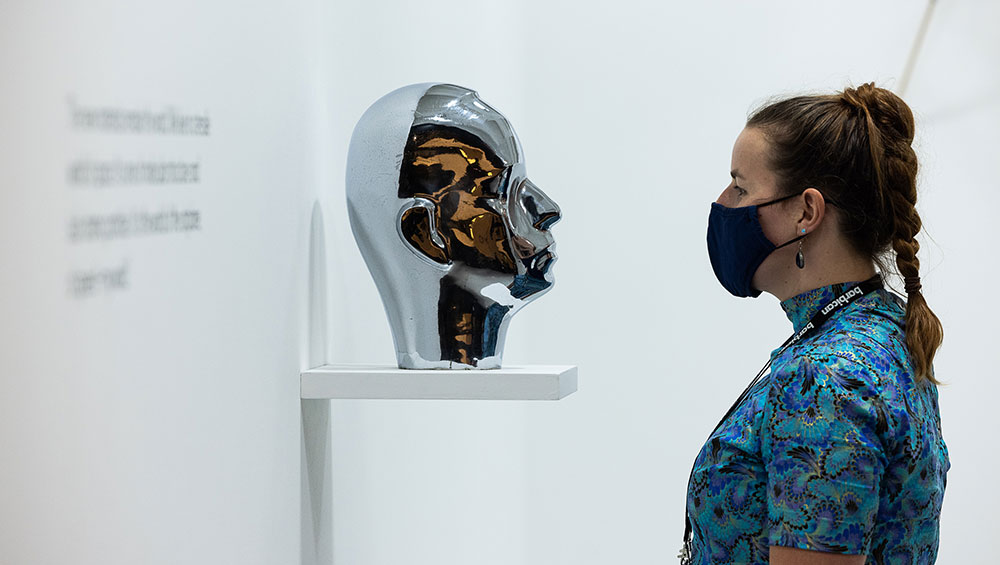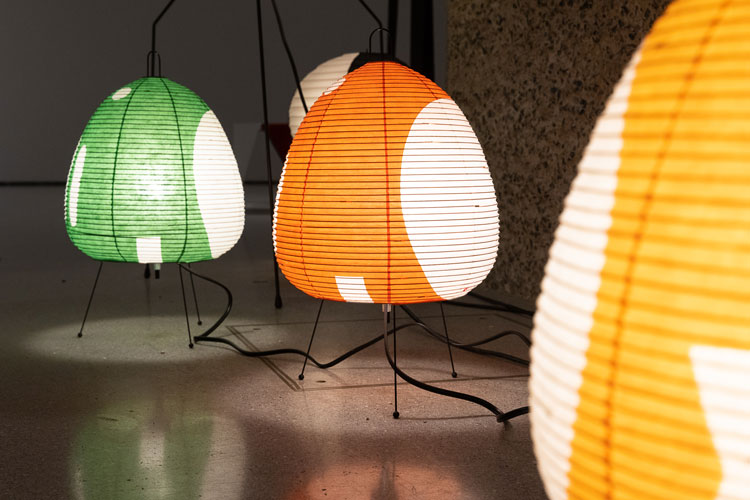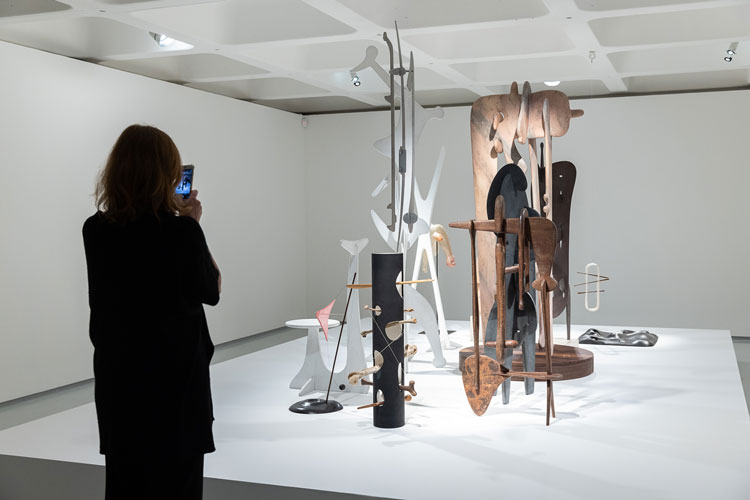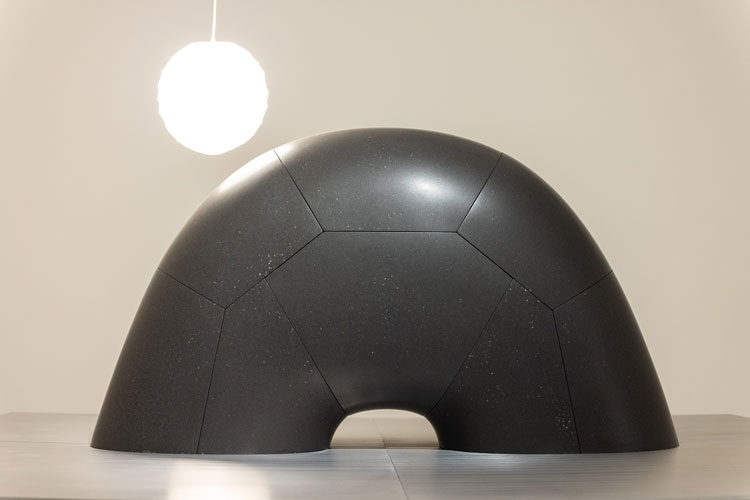
Noguchi. Installation view, Barbican Art Gallery, London, 30 September 2021 – 9 January 2022. © Tim Whitby / Getty Images.
Barbican Art Gallery, London
30 September 2021 – 9 January 2022
by BETH WILLIAMSON
The Japanese-American sculptor Isamu Noguchi (1904-88) is perhaps best known for his coffee table design and Akari lights. This exhibition, the first European touring exhibition of his work in two decades, shows the full range of his sculptural practice over 60 years. Sculptures in stone, bronze, ceramic, wood, aluminium and steel are brought together with theatre set designs, architectural and playground models, lighting and furniture design. Noguchi believed that “sculpture can be a vital force in our everyday life if projected into communal usefulness”, which explains the range of his practice.

Noguchi. Installation view, Barbican Art Gallery, London, 30 September 2021 – 9 January 2022. © Tim Whitby / Getty Images.
He enrolled as a premedical student and studied sculpture at evening classes at the Leonardo da Vinci Art School in New York. There he trained in academic sculpture with Onorio Ruotolo and began his career making portrait busts. That was to change completely when, in 1926, he saw an exhibition of work by Constantin Brâncuşi in New York. The following year, with the help of a Guggenheim Fellowship, he travelled to Paris and became apprenticed to Brancuşi. This inspired Noguchi to turn to modernism and abstraction. Rejecting pure abstraction, he drew on the shapes and structures of living organisms and the natural world to make sculptures such as Globular and Red Seed (both 1928).

Isamu Noguchi, Boy Looking Through Legs (Morning Exercises), 1933. Pear wood, blue beads, 72.4 x 18.7 x 18.1 cm. Photo: Kevin Noble. The Noguchi Museum Archives, 147079. ©INFGM / ARS - DACS.
From 1928 to 1931, Noguchi travelled to London, Moscow, Beijing, Tokyo and Kyoto. His travels became a journey of self-discovery and finding his identity, something he explores in the wonderful Boy Looking Through Legs (Morning Exercises) of 1933, exquisitely carved in pear wood.

Isamu Noguchi, Peking Brush Drawing, 1930. Ink on paper, 89.2 x 146.1 cm. Photo: Kevin Noble. The Noguchi Museum Archives, 01213 ©INFGM / ARS - DACS.
In 1930, in Beijing, he learned traditional ink-brush painting with the Chinese artist Qi Baishi. Peking Brush Drawing and Peking Brush Drawing (Baby With String), both of 1930, demonstrate what the simplicity of line and gesture is capable of conveying. In his designs for playgrounds Play Mountain (1933) and Contoured Playground (1941), he excluded play equipment and instead sculpted the space so that steps and slopes created sculptural landscapes.

Isamu Noguchi, R. Buckminster Fuller, 1929. Bronze, chrome plate, 33.7 x 20 x 25.4 cm. Photo: FS Lincoln. The Noguchi Museum Archives, 01411. ©INFGM / ARS - DACS / Penn State University Libraries.
Noguchi’s close friendship with the inventor, architect and futurist R Buckminster Fuller began in 1929 and Noguchi started to explore new materials. The bronze bust R Buckminster Fuller (1929) was plated in chrome (then a new material used in car manufacturing).

Isamu Noguchi, Radio Nurse and Guardian Ear, 1937, Bakelite. Manufactured by Zenith Radio. Corp. Radio Nurse: 21 x 17.1 x 15.9 cm. Guardian Ear: 15.9 x 10.8 x 21 cm. Photo: Kevin Noble. ©INFGM / ARS – DACS.
Radio Nurse and Guardian Ear (1937) was an intercom made in Bakelite, the world’s first synthetic plastic, for the Zenith Radio Corporation. Noguchi’s interest in choreography was expressed in the sculpture Miss Expanding Universe (1932), designed for the dancer and choreographer Ruth Page, and his Spider Dress for Martha Graham’s Cave of the Heart (1946). Both designs extend the limits of the human body and explore ideas of weight, mass and gravity.

Martha Graham with Spider Dress and Serpent for Martha Graham's Cave of the Heart, 1946. Photo: Cris Alexander. The Noguchi Museum Archives, 01619. ©INFGM / ARS - DACS.
Noguchi made a number of public and political art projects in the 1930s, including the anti-fascist mural History Mexico (1936) in Mexico City. After the Japanese attack on Pearl Harbour and a wave of anti-Japanese feeling in the US, Noguchi volunteered for internment in the Poston War Relocation Center in the Arizona Desert. His lunar works – Lunar Infant, Lunar Landscape (Woman), Red Lunar Fist, all 1944 – emerged as a result of that experience. His self-illuminating works at this time anticipate his making of Akari light sculptures begun in 1951.

Isamu Noguchi, AKARI, 1953. Models; 27N, 2N, BB3-70FF, BB2-S1 14A, BB1-YA1, 31N Paper, bamboo, metal
©INFGM / ARS – DACS / The Kagawa Museum
When Noguchi returned to New York, he returned also to direct carving, in works such as Time Lock (1944-45), which seemed to be safe ground. He said: “These straight carvings were to me the sure things of sculpture, long-lasting (locked against time’s erosion), sculptural sculpture.” Carved from Languedoc marble, this work harks back to the ideas of truth to materials and verticality he first explored with Brancuşi. At this time, he also participated in the exhibition The Imagery of Chess (1944-45) and the chess set on show at the Barbican is fascinating.

Noguchi. Installation view, Barbican Art Gallery, London, 30 September 2021 – 9 January 2022. © Tim Whitby / Getty Images.
After the second world war, Noguchi’s artistic practice addressed wartime anxieties and, along with many artists, he began to search for a new cultural foundation. In works such as Skin and Bones (Bone and Skin) (1950), Gregory (Effigy) (1945) and Monument to Heroes (1943), the pain and violence of war is palpable. This Tortured Earth (1942-43) is based on a bomb site and, in the artist’s words, was made “to memorialise the tragedy of war. There is injury to the earth itself.” It’s a startling thought.
Cronos (1947) represents an important development in Noguchi’s interlocking sculptures. With its mythological references, Cronos also explores the violence and destruction of the second world war. Made from fragile balsa wood, it perhaps reflects on the fragility of humanity too. Mortality (1959) similarly explores the idea of the fragility of human life. As Noguchi put it: “Our pendulous and precarious existence is shaped by gravity.”

Noguchi. Installation view, Barbican Art Gallery, London, 30 September 2021 – 9 January 2022. © Tim Whitby / Getty Images.
When Noguchi returned to Japan in 1950, he seemed to turn again to tradition, but his approach to craft techniques was innovative. He looked to the past to find a way forward in his work that might speak to a common humanity: “An innocent synthesis must rise from the embers of the past.” Sculpture to Be Seen from Mars (1947) tells of a post-atomic world, humanity extinct, and the abandoned Earth being viewed from Mars by a non-human species, the desolation clear to see. It’s devastating.

Isamu Noguchi, Trinity (Triple), 1945 (fabricated 1988). Bronze plate, 141.6 x 56.5 x 49.5 cm. Photo: Kevin Noble. The Noguchi Museum Archives, 9891 ©INFGM / ARS – DACS.
Noguchi’s bronze sculpture Trinity, Triple (1945) deals with nuclear fission and the artist’s concerns about the impact of advances in technology. The effect of such transformations was troubling. In later work, he began to find new ways to transform natural materials. For instance, The Inner Stone (1973) was made by drilling a hole into the basalt rock using a rotating pipe.
The sculptural landscapes he had envisioned early in his career were often unrealised. Later, he had more success. He created the Unesco Gardens in Paris (1956-58), importing stone from Japan. He also created The Billy Rose Sculpture Garden (1960-65) for the Israel Museum in Jerusalem and Sunken Garden (1961-64) for Chase Manhattan Bank Plaza in New York. These and other civic projects enabled him to create environments that he hoped would enhance the lives of those who used them.

Isamu Noguchi, Sunken Garden for Beinecke Rare Book and Manuscript Library, 1960-64. Exterior design with Imperial Danby marble. Photo: Ezra Stoller / ESTO. The Noguchi Museum Archives, 01898. ©INFGM / ARS - DACS /ESTO.
Noguchi’s travels in Europe, Asia, India and elsewhere from 1949 were a period of exploration when he observed and recorded how people engaged with civic spaces and sacred sites. He wanted to understand how he could bring sculpture to existing cultural traditions and, at the same time, use modern technology in his quest. His desire was to “bring sculpture into a more direct involvement with the common experience of living”. Perhaps his most direct legacy is the Noguchi Museum in New York City, opened in 1985. With an outdoor sculpture garden and a building filled with sculpture, photographs, drawings and models by the artist, it sounds like the perfect setting to see his work. The Barbican with its fountains, pools and greenery amid the concrete has got to be close second. As you leave the exhibition, a number of films of Noguchi talking about his work convey his real zest for life and his passion for sculpture, in its widest sense, as a vital force in everyday life. It is inspiring.
• This touring exhibition will be at the Museum Ludwig, Cologne, from 26 March to 31 July 2022, the Zentrum Paul Klee, Bern, from 23 September 2022 to 8 January 2023 and the Lille Métropole Musée d’art Moderne, from 6 April to 16 July 2023.